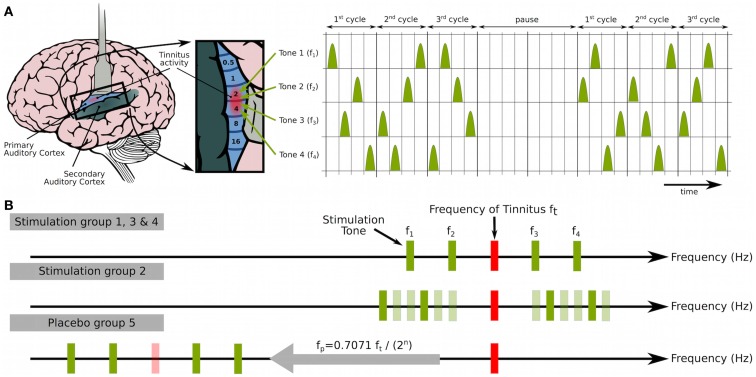Figure 1.
Acoustic coordinated reset (CR) neuromodulation. (A) CR neuromodulation means to deliver phase resetting stimuli to neuronal subpopulations in a spatiotemporally coordinated manner in order to induce desynchronization and eventually anti-kindling (104, 109, 110): employing the tonotopic organization of the primary auditory cortex [left, brain adapted from Chittka and Brockmann (135) with kind permission of the authors] short sinusoidal tones of different frequencies were grouped within approximately one octave around the tinnitus frequency ft (f1 = 0.77 ft, f4 = 1,40 ft) to induce a soft reset (134) of different parts of the synchronized tinnitus focus, respectively. Three CR cycles, each containing a randomized sequence of four tones (left), were followed by two silent cycles (“pause”). That pattern was repeated periodically [compare (104, 109, 110, 115)]. (B) The proof of concept study by Tass et al. (132) comprised four stimulation groups (G1–G4) and one placebo group (G5), where G2 served as active control group. Patients in groups G1, G3, and G4 were treated with acoustic CR neuromodulation, i.e., with four tones (top, f1–f4) grouped around the tinnitus frequency (ft). In all patients, ft was assessed with a pure tone matching. G3 differs only in repetition rate F (i.e., the inverse of the duration of a cycle), which was adapted to the individual EEG δ-band peak at each visit. According to computational studies, continuous online adaptation of F should be beneficial (109, 110). In all other groups, the repetition rate F was set to 1.5 Hz to target delta oscillations (109, 110). Stimulation dosage was 4–6 h/day in G1–G3 and 1 h/day in G4 and G5. For G2 in each CR cycle, a random selection of four tones (dark green: active) was taken out of 12 (middle, f1–f12) surrounding ft. For placebo stimulation (bottom, G5), a similar pattern as for G1 was used, but with down-shifted stimulation frequency fp [fp = 0.7071 ft/(2n), and fp within (300 Hz, 600 Hz)] to ensure stimulation outside the synchronized tinnitus focus. Figure from Tass et al. (132) with kind permission by the authors. Copyright by Forschungszentrum Jülich GmbH.

